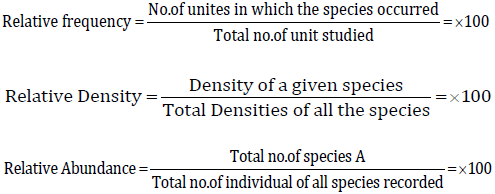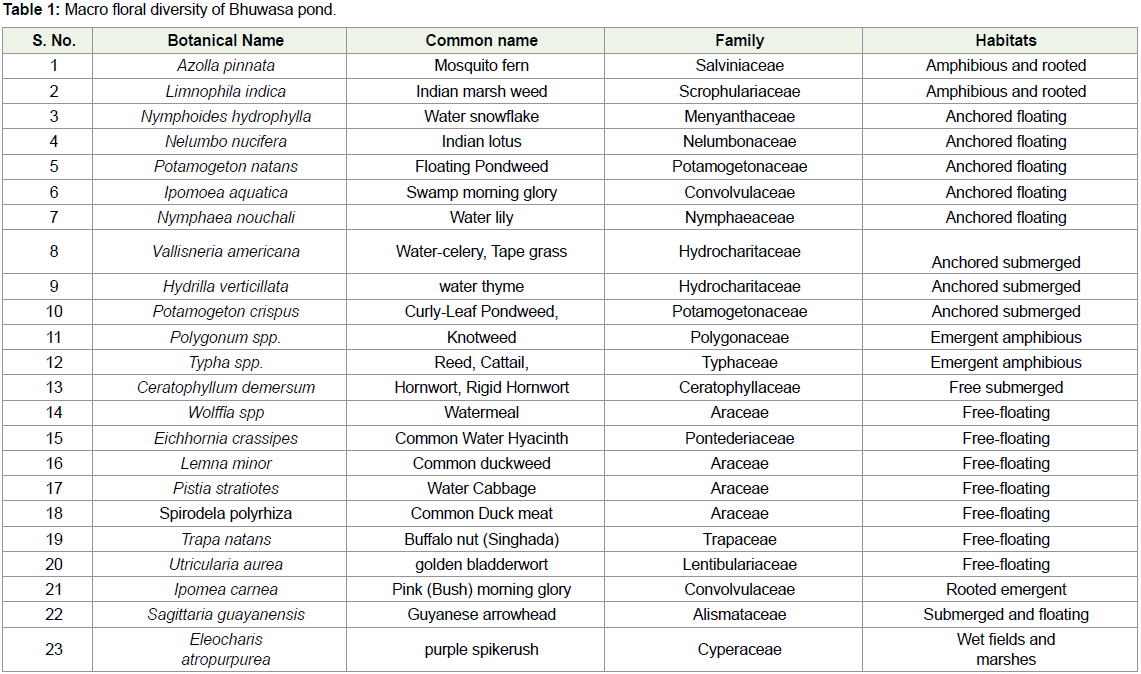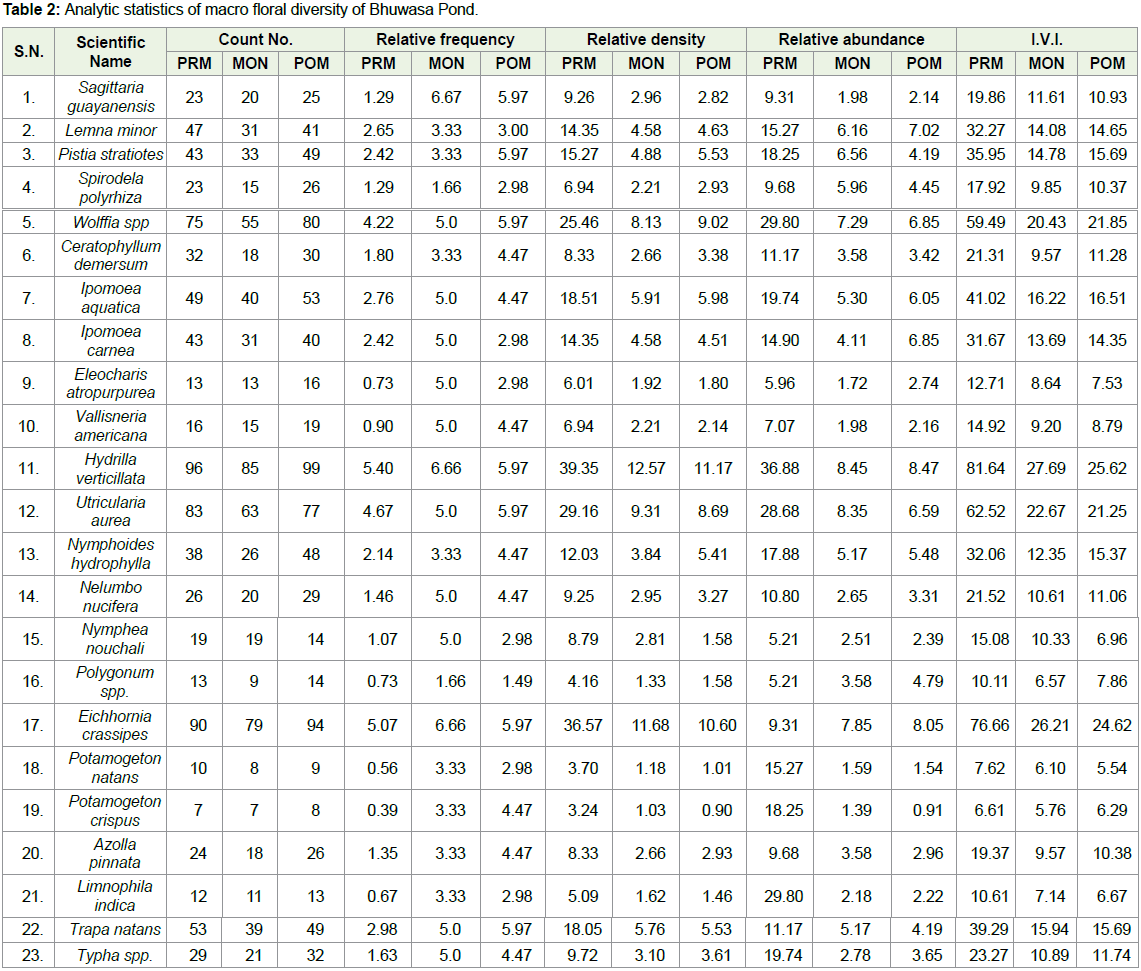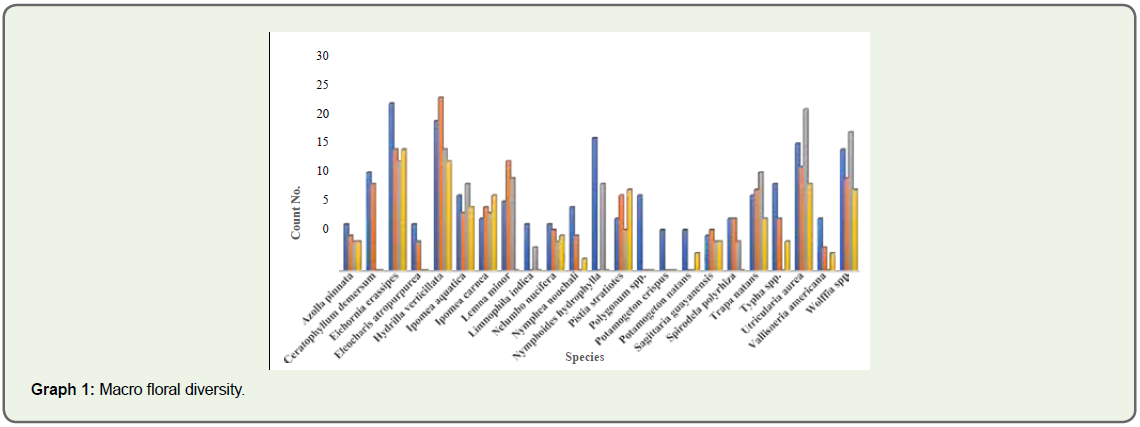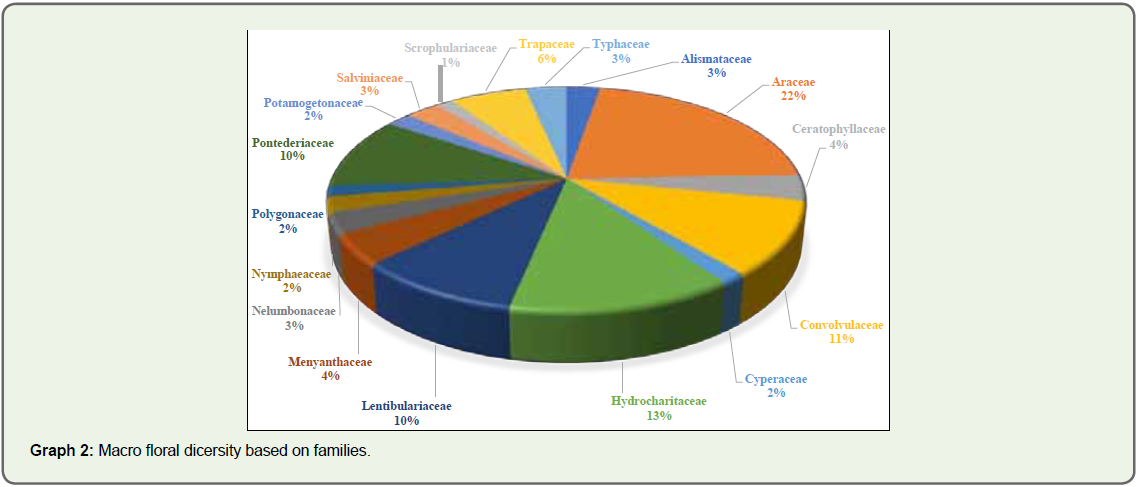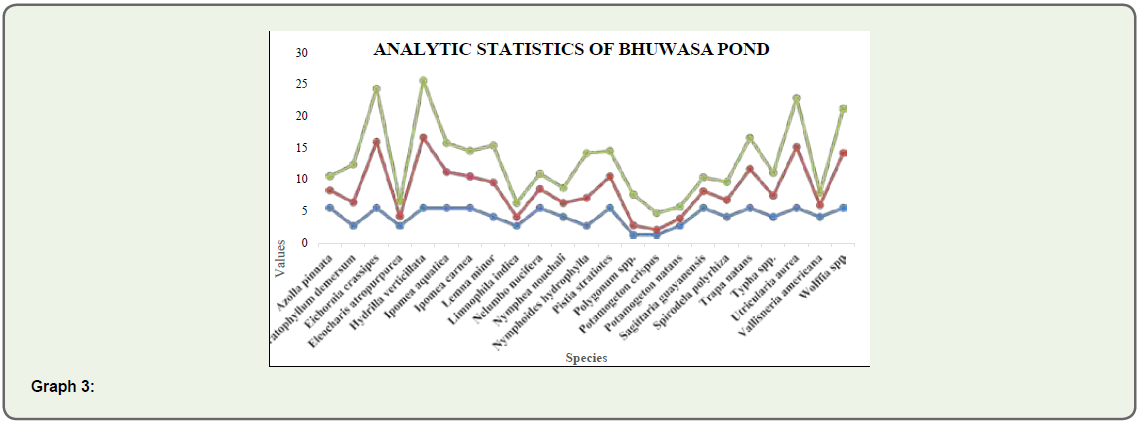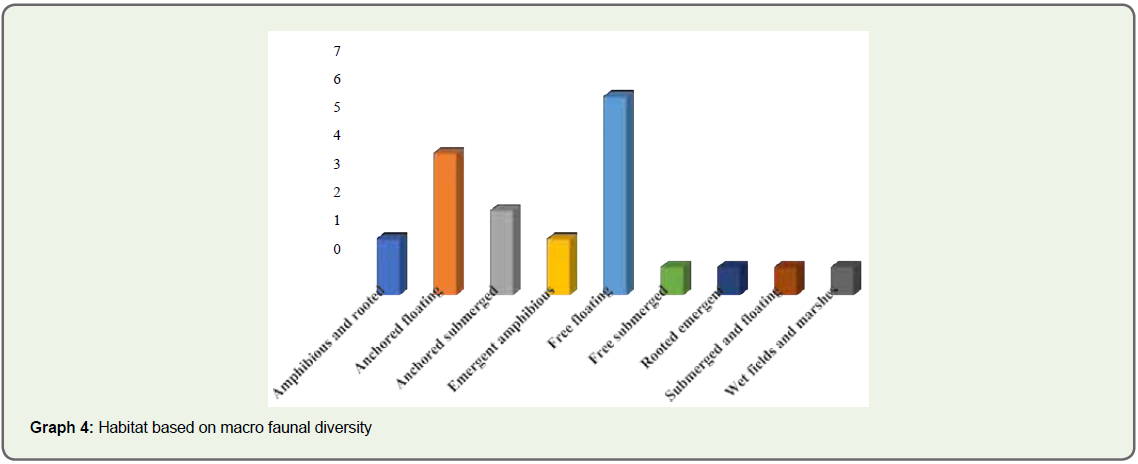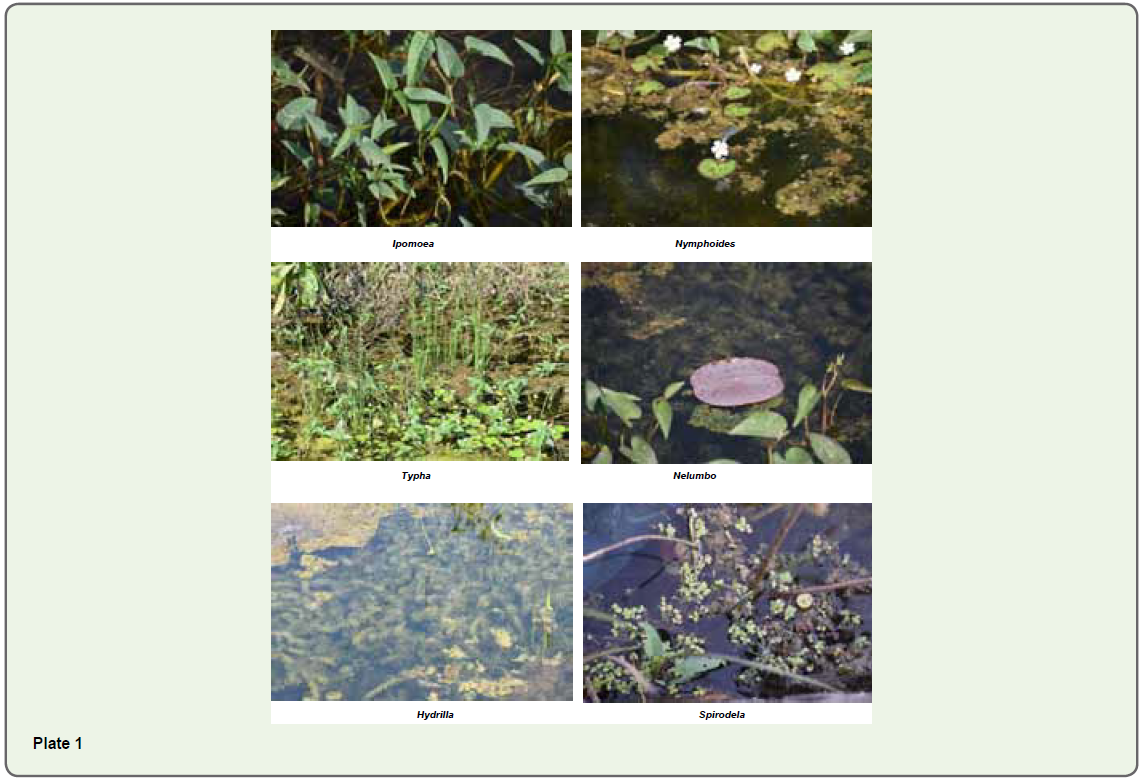Research Article
Distribution and Seasonal Changes of Aquatic Macro Floral Diversity in Bhuwasa Pond of Banswara Southern Rajasthan
Chauhan NS1*, Upadhya J1, Chaudhary L2 and Bharadwaj S3
1Department of Botany, Shreenath PG Colege, Dungarpur
2Department of Zoology, Leo College, Banswara
3Department of Zoology, HDJ Government PG College, Banswara
*Corresponding author: Bharadwaj S, Department of Zoology, HDJ Government PG College, Banswara; E-mail:
Seema377@gmail.com
Copyright: © Chauhan NS, et al. 2023. This is an open access article distributed under the Creative Commons Attribution License,
which permits unrestricted use, distribution, and reproduction in any medium, provided the original work is properly cited.
Article Information: Submission: 07/01/2023; Accepted: 10/02/2023; Published: 15/02/2023
Abstract
The study presents the macro floral diversity of the Bhuwasa pond. It provides sensitive and cost-effective means of assessing the water quality of this
pond. Aquatic macro floral diversity and its role in understanding this pond ecosystem have vast significance. 23 species of aquatic macrophytes belonging
to 17 families. Free-floating (7 species) showed the largest number in our study, followed by anchored floating (5 species), anchored submerged (3 species),
amphibious & rooted (2 species), emergent amphibious (2 species), free submerged (1 species), rooted emergent (1 species), submerged and floating (1
species) and wet fields and marshes (1 species) during the seasons (pre-monsoon, monsoon & post-monsoon). Shannon-Wiener’s indices were from 2.91
to 2.94 for all species in different seasons. Simpson’s diversity indices were from 0.93 to 0.95 for all species found in different seasons. Evenness were from
0.5 to 0.95 and species richness were 2.0 to 3.5 also recorded in all seasons.
Keywords
Macro floral diversity; Bhuwasa pond; Abundance; Diversity index
Introduction
Plants have evolved in many different ways of surviving in
aquatic conditions and some have thick wax or hairy leaves so that
the leaves are unwetable that types of aquatic plants are hydrophytic
and macrophytes. Aquatic macrophytes are adapted to live in water.
These are aquatic photosynthetic organisms large enough to be seen
with the naked eye that actively grows permanently or periodically
submerged floating or growing on the water’s surface. The present
study is planned to explore Bhuwasa Pond for the species diversity
of aquatic macrophytes. Commonly occurring species were noticed
during the period of study. Most of these macrophytes grow naturally
here.
Aquatic plants play a vital role in aquatic ecology. Macrophytes may enhance the variability of ecologically relevant physicochemical
variables and impede mixing processes [1-3]. These macrophytes can
change the quantity, composition and distribution of other aquatic
organisms.
when they are abundant. Aquatic plants provide food for Water
birds and other animals, establishing the foundation for aquatic
wildlife conservation efforts. Researchers such as have examined
the macrophytes of several water bodies in India [4-10]. Aquatic
macrophytes are a group of plants that survive in wet habitats,
including angiosperms, ferns, mosses, liverworts, and certain
macroalgae [11]. It refers to plants visible to the human eye with at
least some vegetative parts growing in permanent or intermittent
water environments [12]. Aquatic angiosperms (flowering plants), pteridophytes (ferns) and bryophytes are the prominent plants that
dominate marshes, shallow lakes and streams (mosses, liverworts,
hornworts), where nitrogen loading is high, and they often develop
more aggressively. Aquatic macrophytes are vital components of
freshwater ecosystems that reflect the ecosystem’s overall health [13].
Aquatic macrophytes are impacted by water quality and they
provide food, shelter and breeding places for aquatic fauna. These
macrophytes may be floating unattached plants (plants with the
majority of the plant at or near the water’s surface rooted and floating
freely in the water and are not anchored to the bottom), floating
attached plants (plants with floating leaves with stems under the
surface and roots that anchor the plant to the substrate), submerged
plants are found when the entire plant is submerged under the water’s
surface and emergent plants (plants with roots that grow below
water but stems and leaves that grow on the water surface) [14].
Macrophytes thrive in such conditions and sediments, where they
may best root and endure the water’s erosive power during periodic
scour episodes [15].
Macrophytes are those plants that grow in or near water and are
emergent, submerged or floating. These modify themselves to survive
in the aquatic environment. Their distribution is specific and depends
on the water quality and environmental conditions. Macrophytes are
unchangeable biological filters and carry out purification of the water
bodies by accumulating dissolved metals and toxins in their tissues
[16]. The variation in water chemistry can be assessed by surveying
the abundance of macrophytic communities. The trophic nature
has mainly influenced the variety of communities and indicator
species that occur at particular sources. The macrophytes restore the
extension of phytoplankton and help in the reuse of organic matter.
The submerged species of macrophytes also act as green manure,
favorable to the abundance of zooplankton and benthic fauna
[17,18]. Aquatic macrophytes in ponds play a vital ecological balance
and help stabilize and regulate the trophic state. They serve as bioindicators
also. They significantly affect soil chemistry and light levels
as they capture pollutants and trap sediments. Excess sediment will
settle into the benthos aided by the reduction of flow rates caused
by the presence of plants stems, leaves and roots. Macrophytes often
grow more vigorously where nutrient loading is high.
Aquatic macrophytes play a vital role in making a healthy
ecosystem and serve as primary producers of oxygen through
photosynthesis. It provides a substratum for algae, protection for
benthic fauna and a breeding ground for fish. Biodiversity and
ecosystem-oriented studies with particular reference to macrophytes
in freshwater bodies have attracted many research workers [19-21].
Materials & Methods
Aquatic macrophytes samples were collected during the early
morning on a seasonal basis from each sampling site during the study
period from July 2021 to June 2022 (pre-monsoon, monsoon and
post-monsoon season). The identification of macrophytes was done
with the help of standard books, monographs and identification keys
[22-24].
Macrophytes in shallow water were immediately gathered,
whereas those in deeper water were caught using a long-handled hook. The specimen was carefully cleaned and surplus water was
absorbed with filter paper and stored in polythene bags lined with
filter paper until transported to the laboratory. It was preserved in 5%
formalin and then examined. Three replicate samples were collected
from two stations with a hand net of 50 cm x 50 cm from the littoral
zone. The macrophyte leaves and roots were then washed thoroughly
several times in the net itself, removing all attached faunas manually
from each strand with the help of a magnifying glass. A boat was
used to collect data on macrophytes throughout the shoreline. A
tub was used to collect submerged plants from the boat. A 1mx1m
light wooden quadrat was used for a random sample approach. Hand
plucking was used to count the macrophytes.
Importance Value Index (I.V.I.):
Importance value index = Relative frequency + Relative density +
Relative dominance,Where, Relative frequency = number of occurrences of one
species, Relative density = number of individuals of one species,
Relative dominance = Total area coverage (by visual estimation)
Simpson’s Dominance Index (D): - The Simpson’s index (D) is
calculated using the following equation:
It represents the probability that two individual organisms
randomly selected from a sample will belong to different species.
Shannon-Wiener Index (H’):
This is a frequently used approach for measuring biotic
diversity in aquatic and terrestrial habitats.The Shannon index considers both species richness and
abundance. It’s just the distribution’s information entropy, with
species as symbols and relative population sizes as probabilities.
Evenness Index (E):
This is the relative distribution of members within a community
among taxonomic categories:
E= H’/logS
Where log S= Natural log of the total number of species
H’ = Shannon - Wiener diversity index. It refers to how evenly
the abundances of the different groups in a sample or community are
distributed.Abundance and Density:
Both of these terms refer to the number of species in a community. Individual species abundance is reported as a proportion of the total
number of species present in the community, making it a relative
metric. Particular species are enumerated instead of merely their
presence or absence being studied while sampling the abundance of
a species. When defining the community structure, abundance and
frequency is quite important.Results & Discussion
23 species belonging to 17 families of aquatic macrophytes were
recorded in the present investigation (Table 1). In terms of species
number of plants, free-floating (7 species) showed the largest number
in our study, followed by anchored floating (5 species), anchored
submerged (3 species), amphibious & rooted (2 species), emergent
amphibious (2 species), free submerged (1 species), rooted emergent
(1 species), submerged and floating (1 species) and wet fields and
marshes (1 species) during the seasons (pre-monsoon, monsoon &
post-monsoon). In terms of individual numbers, free-floating was the
most dominant during the post-monsoon, while anchored floating
and anchored submerged were dominant rest of the other seasons.
Wolffia sp., Eichhornia sp. and Lemna sp. were found dominant during post-monsoon. Hydrilla sp. and Lemna sp. were the most
during pre-monsoon Chara sp., Utricularia sp. and Eichhornia sp.
were dominant during monsoon.
Seasonally, the important value index was highest in the postmonsoon
(P.O.M.), which is followed by Hydrilla (dominating),
Eichhornia, Utricularia, Wolffia, Ipomoea, Trapa, Lemna, Pistia and
Nymphaea during pre-monsoon and monsoon. It was studied that
excessive growth of aquatic weeds can be used as a bioindicator of
water quality. In this study, anchored submerged, Hydrilla sp. was
observed to be the most dominant genus in all seasons, such growth
of the Hydrilla indicates that it is able to adapt to water conditions
(Table 2). Similar findings regarding Hydrilla sp. are reported by [25].
Shannon-Wiener’s index for all species was found in the postmonsoon
(2.93), as compared to the pre-monsoon (2.92) and
monsoon (2.91). Simpson’s diversity indices for all species were found
in post-monsoon (0.95), as compared to the pre-monsoon (0.94) and
monsoon (0.93). The lowest diversity indices were observed during
monsoon as compared to the other two seasons. Evenness (0.5-0.95)
and Species richness (2.0-3.5) were also recorded for all seasons.
Similar findings regarding indices are reported by [26]. Low diversity
values of Shannon- Wiener’s index and Simpson’s diversity indices
indicated that the Bhuwasa pond shows initial polluted conditions
due to anthropogenic activities. Aquatic macrophytes provide food,
shelter and a place for breeding therefore; it is an ideal component
of aquatic wildlife conservation strategies. The growth of aquatic
macrophytes indicates the presence of pollution in water. Aquatic
macrophytes serve as the foundation for many micro and macroorganisms.
Table 1 and 2 summarize the all information and graphs from 1 to
4 show different types of macro floral diversity of the Bhuwasa pond.
Conclusion
Because of their growing relevance in an aquatic ecosystem, the
study of aquatic macrophytes has risen dramatically during the last
century. It contributes significantly to the structure and operation
of the aquatic ecosystem. It impacts the hydrological and physicochemical
environments, as well as supplying food and habitat to a
variety of organisms.



